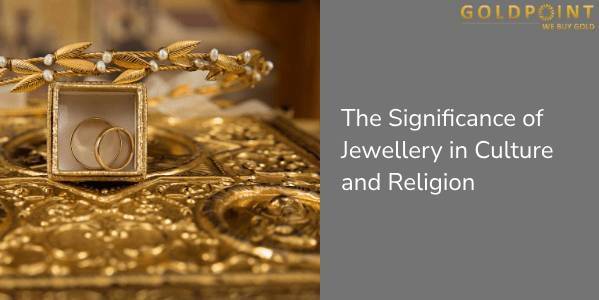
- మే, 07 2023
- | Sell Gold
The Significance of Jewellery in Culture and Religion
Jewellery has long been associated with wealth, prosperity, and social status, around the world. The quality and quantity of jewellery one possesses often symbolise their affluence and position within the community. But in Indian society, jewellery is far more than a symbol of wealth and prosperity.
For Indians, jewellery holds immense significance both in a cultural and religious sense. Many jewellery pieces in Indian culture are rich in symbolism and carry sacred meanings. For instance, the mangalsutra, a necklace worn by married Hindu women, signifies marital status and represents the bond between husband and wife.
Similarly, there are various other jewellery types that play a vital role in Indian culture and traditions. They also form an integral part of various ceremonies and festivities, such as weddings, cultural festivals, and religious rituals. Besides, jewellery is also often passed down through generations, representing family heritage and traditions.
Moving forward with our discussion, this post delves into the profound cultural and religious significance of various jewellery pieces. Let’s read on.
1. Navaratna Ring
A Navratna ring is a traditional piece of jewellery that holds immense astrological significance. It features nine specific gemstones representing celestial bodies in Vedic astrology, such as the Sun, Moon, and planets. Each gemstone is believed to correspond to a particular cosmic energy, and wearing a Navratna ring is thought to balance these energies, bringing harmony, positive vibrations, and good fortune to the wearer.
Additional Read: Digital Gold Vs Physical Gold
2. Toe Ring
Toe rings have a special place in Indian culture, particularly for married women. Worn on the second toe, they signify the sacred bond of marriage and the commitment between spouses. Beyond their symbolism, toe rings are passed down as heirlooms, carrying the blessings and well wishes of previous generations. They embody the essence of cultural heritage, reminding women of their marital vows and symbolising the timeless values of love, devotion, and tradition.
3. Nose Pin
In Indian culture, the nose pin holds cultural significance and personal expression for women. It has been adorned for centuries and represents beauty, femininity, and individuality. Nose pins come in various designs, reflecting diverse regional styles and artistic expressions. Their purpose extends beyond adornment, as this piece of jewellery holds a deeper symbolic meaning, embodying cultural identity, confidence, and a profound connection to one’s ancestral heritage.
4. Mangalsutra
The mangalsutra is a sacred necklace worn by married women in India. It is a symbol of marital unity, love, and commitment. Composed of black and gold beads, it represents the inseparable bond between husband and wife. Each bead signifies a prayer for the well-being and long life of the spouse. The mangalsutra is not just an accessory but a reflection of the sacred vows exchanged during the wedding ceremony, serving as a constant reminder of the marital bond and the values of trust, respect, and togetherness.
5. Bangles
Bangles hold a special place in Indian culture, transcending their role as decorative accessories. They are worn by women of all ages and signify femininity, tradition, and celebration. Special occasions like festivals, weddings, and religious ceremonies call for the adornment of bangles, which come in different materials, designs, and colours. They jingle and create a beautiful melody, symbolising joy, prosperity, and good luck. Bangles also hold sentimental value, representing the bonds of sisterhood, friendship, and family.
The Financial Significance of Jewellery
As we uncover the cultural and religious meanings embedded in jewellery, it is important to acknowledge the fluidity of our connection to these valuable artefacts. In modern times, we not only appreciate the symbolic and sentimental value of jewellery but also recognise its potential financial significance. For instance, if you need immediate funds, then you can opt for the cash for gold option available at Muthoot Gold Point.
Note – You can use a gold calculator to determine the approximate value of your traditional gold jewellery. It takes into account the weight, purity, and current market price of gold to calculate an estimated value.
Final Word
Jewellery plays an important role in Indian culture and tradition, serving as a tangible expression of beliefs, traditions, and identity. Additionally, gold holds the distinction of being an easily liquidated commodity, making it a preferred choice for investment and financial security.
At Muthoot Gold Point, we provide customers with the opportunity to sell their gold for cash, ensuring a convenient and transparent process. Sellers can also utilise our gold price calculator, empowering them to ascertain the best possible price for their precious gold assets.










